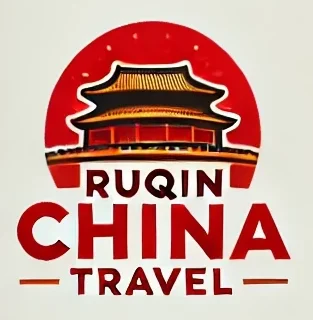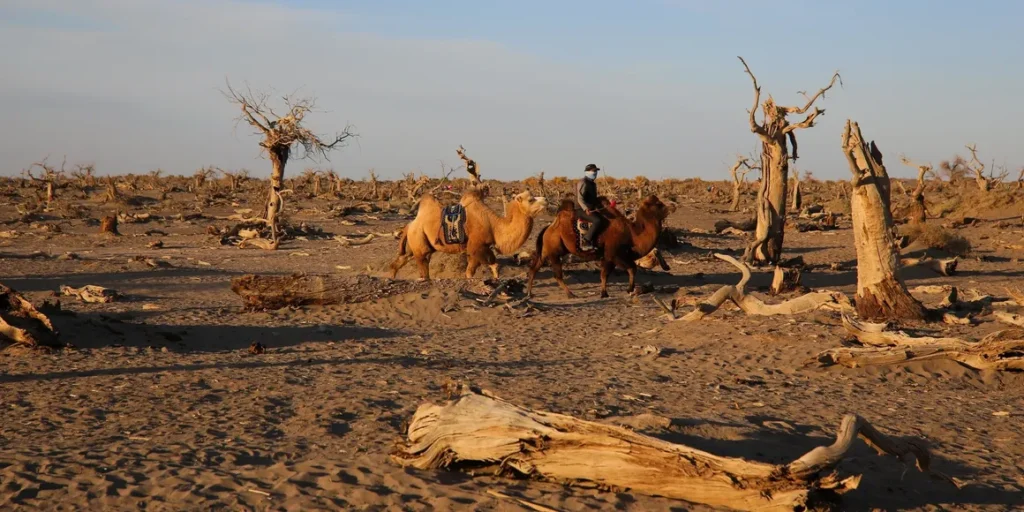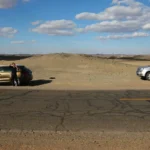Welcome to Alxa League, or Alashan League (内蒙古阿拉善盟)— a remote wonder tucked into the far west of Inner Mongolia. This region is a dramatic blend of vast deserts, wild Gobi plains, lush oases, and golden poplar forests. Here, the ancient ruins of the mysterious Heicheng (Black City) whisper stories of Silk Road legends, while the towering dunes of the Badain Jaran Desert — the fourth largest in the world — ripple endlessly under the sky. Every autumn, the poplar trees of Ejina burn bright like flames, transforming the land into a sea of gold.
For foreign travelers seeking to explore the raw beauty of China’s frontiers, Alxa League offers a perfect escape. It’s more than just a destination — it’s where nature, history, and nomadic culture meet. In this detailed guide, you’ll learn how to plan a safe, immersive, and unforgettable journey through one of China’s most unique regions.
1. Preparing for Your Trip to Alxa League
Before diving into the deserts and grasslands of Alxa League, it’s important to prepare well. After all, this is not your average destination. Alxa covers a huge area and includes everything from sand dunes to wetlands. The climate shifts quickly — one minute you’re under a blazing sun, and the next, you’re in chilly mountain air. So, packing smartly can really improve your trip.
First, make sure your travel documents are in order. You’ll need a valid Chinese visa. No special permit is needed for Alxa League itself. However, if you plan to visit the border areas like Ceke Port, check in advance for extra documentation. It’s also a good idea to keep copies of your passport and visa on your phone and in the cloud.
Next, think about health. Some areas, like Helan Mountain, are at higher altitudes. Talk to your doctor about altitude sickness prevention. Also, deserts here have strong UV rays and big temperature drops at night. So, bring sunscreen, lip balm, and warm clothes. Don’t forget travel insurance — especially one that covers desert emergencies and evacuation.
Money-wise, carry enough cash. Mobile payments like WeChat Pay are less common in rural areas. Major hotels might accept cards, but small shops and scenic areas often prefer cash. ATMs can be scarce, so it’s best to withdraw money in cities like Yinchuan before heading out.
Language helps too. While Mandarin is widely spoken, learning a few basic Mongolian phrases can warm hearts. Words like “hello” (Sain baina uu) and “thank you” (Bayarlalaa) go a long way. Locals truly appreciate it.
Now let’s talk timing. Alxa shines differently each season. Spring (April–May) is mild and quiet — great for avoiding crowds. Summer (June–August) is hot but perfect for stargazing and desert camping. Autumn (September–October) is the best — especially for the golden poplar forests. Winter (November–March) is freezing, but the snowy desert is uniquely beautiful.
What to pack? Here’s a simple list:
- High-ankle desert boots or sturdy hiking shoes
- Sandproof scarf, sunglasses, and wide-brim hat
- SPF 50+ sunscreen and lip balm
- Layered clothing — light for day, warm for night
- Insulated water bottle
- Headlamp or flashlight for camping
- Camera and spare batteries
- A small backpack (ideally sand-resistant)
Lastly, learn a bit about Mongolian customs. For example, never step on the threshold of a yurt. Always use both hands when giving or receiving things. Don’t touch people’s heads, and never point at Buddha statues in temples. Respecting local traditions makes your journey more meaningful — and much smoother.
2. How to Get to Alxa League – A Transportation Guide for Foreign Visitors
Alxa League may feel like the edge of the world, but getting there is easier than you think. Although remote, this part of western Inner Mongolia is now more connected than ever. With a little planning, travelers from around the globe can reach this desert gem through a mix of international and domestic routes.
International Flights: Your First Step into China
Let’s start with international access. Alxa League does not have its own international airport. So first, you’ll need to fly into one of China’s major gateway cities — usually Beijing, Shanghai, or Guangzhou. From there, you can catch a domestic flight to the region.
The nearest major international airport is Yinchuan Hedong Airport (INC) in neighboring Ningxia. It’s about 110 km (a 1.5-hour drive) from Bayanhot, the capital of Alxa League. As a price reference:
- Flights from Asia (like Seoul or Tokyo) to Yinchuan range from $400 to $800 USD round-trip.
- From Europe (like Paris or Frankfurt), expect $800–$1500 USD.
- From North America (such as Los Angeles), prices can reach $900–$1600 USD.
Domestic Travel: Flying, Driving, or Rolling In
Already in China? Great. You’ve got a few good options.
By Plane:
This is the quickest way. Direct flights run from Beijing, Xi’an, and Hohhot to Bayanhot Airport (AXF). Flights take 1.5 to 2 hours and cost about 500–1200 RMB. If you’re heading for the golden poplar forests, you can fly to Tolare Airport near Ejina — though flights here are less frequent, mostly from Xi’an and Bayanhot.
By Train:
Trains are available from cities like Hohhot and Baotou, but they take over 10 hours and aren’t frequent. A better strategy? Take a high-speed train to Yinchuan first (about 7 hours from Beijing), then continue by car or bus.
By Long-Distance Bus:
Frequent buses from Yinchuan Bus Station reach Bayanhot in about 2 hours for around 60 RMB. If you’re going from Bayanhot to Ejina, expect an 8–10 hour ride, costing around 180 RMB.
By Car (Self-Driving):
Yes, you can drive yourself. China accepts international driver’s license translations (not the original IDP). Rental cars are available in Yinchuan. The G7 Expressway, dubbed “China’s Route 66,” cuts right through Alxa. Desert views here are jaw-dropping. However, avoid venturing deep into the sands unless you have a 4WD and solid desert driving experience.
Getting Around Inside Alxa League
Alxa League is huge — roughly the size of Portugal! That means getting around takes time, and some local planning really pays off.
Private Car Hire:
The most flexible option for small groups is hiring a driver. Rates range from 400 to 800 RMB per day. For desert or grassland areas, go with a local driver who knows the terrain.
Tourist Shuttle Buses:
Popular spots like the poplar forest and Heicheng Ruins have special tourist buses, but they run on limited schedules. Be sure to check timetables in advance.
Regional Flights:
There are small aircraft connecting Bayanhot and Ejina. Flights take about one hour and are perfect if you’re tight on time.
Desert-Style Rides:
Camel rides, desert jeeps, and dune buggies aren’t just fun — they’re often practical in certain scenic zones.
In-Town Transport (Bayanhot, etc.):
Bayanhot is a small town, so getting around is simple.
- Taxis start at 6 RMB. You can also use the DiDi app, though you’ll need a local SIM card.
- Local buses are cheap (1–2 RMB) and cover most areas.
- Bikes are available from some hotels for short city rides.
Travel Tips on Transportation:
Some areas near the border are under military control. Respect signage, and don’t stop for photos in restricted zones.
Download offline maps (like Maps.me or Gaode) — you might lose signal in the desert.
During peak poplar season (late September–October), book flights and buses early — they sell out fast.
To visit remote sites like Badain Jaran Desert, go with a guide or local tour — it’s safer.
Fuel up if you’re driving. Gas stations are few and far between in the desert.
3. Must-See Attractions in Alxa League – Where Desert Wonders Meet Ancient Culture
Alxa League is a dreamland of wild beauty and cultural depth. From golden forests to towering dunes, this region offers some of China’s most surreal landscapes. First-time visitors might feel overwhelmed by the options. So, we’ve handpicked the top places that blend nature, history, and local culture. These highlights will help you plan a desert-and-grassland journey you’ll never forget.
Ejina Populus Euphratica Forest
Nicknamed the “Golden Miracle of the Desert,” Ejina’s poplar forest is one of the largest of its kind in the world. These ancient trees, known for living over 1,000 years, light up in dazzling gold each October. Spanning over 380,000 acres, the forest stretches across scenic bridges numbered from First to Eighth. The reflections at the Second Bridge and the heroic grove at the Fourth Bridge are truly breathtaking. Tickets cost ¥240 (includes shuttle buses). Plan to spend a full day. For stunning photos, visit at sunrise or sunset.
Badain Jaran Desert
This is not just another desert — it’s a spectacle. Known for its “singing sands,” colorful salt lakes, and sacred springs, Badain Jaran is China’s third-largest desert and home to the world’s tallest sand dune, Bilutu Peak (over 500 meters high). With more than 140 lakes scattered across the dunes, this place feels almost alien. You can try off-road driving, camel trekking, and even stay with herders in the heart of the sands. A 2–3 day trip is ideal. Car hire (with driver and basic lodging) costs around ¥1,500–2,000.
Heicheng Ruins & “Ghost Tree Forest”
Once a thriving fortress on the Silk Road, Heicheng was built by the Western Xia Dynasty. Now a ghost town, it was abandoned in the 14th century when its water source dried up. The ruins still hold ancient towers and broken walls, glowing gold in the setting sun. Nearby is the “Dead Forest,” a haunting stretch of wind-sculpted, dead poplar trees. It’s a dream for photographers. Entry to both sites is ¥120. Sunset is the best time to visit.
Juyanhai Lake
Also known as Juyan Marsh, this seasonal lake was once a key watering hole on the ancient Silk Road. Today, it’s a paradise for bird lovers. Thousands of migratory birds like swans and cranes visit each spring and fall. The sunrise here is legendary — reeds swaying in golden light while flocks take flight. Tickets are ¥60. Arrive around 5 a.m. to catch the magical dawn.
Helan Mountain South Temple (Guangzong Temple)
Hidden in the Helan Mountains, this Tibetan Buddhist temple is peaceful and sacred. It honors the Sixth Dalai Lama, with his stupa enshrined inside. Surrounded by lotus-shaped peaks, the temple feels timeless. Behind it lies “Xuelingzi,” a wild forest where the weather shifts through four seasons in one day. Tickets are ¥80 (includes shuttle to the forest trail). Allow 4–5 hours, and remember to walk clockwise in religious spaces.
Moon Lake, Tengger Desert
Deep in the Tengger Desert, Moon Lake is a salt-and-freshwater mix that mirrors the shape of China on a map. It supports wildlife and is home to a desert eco-resort. Guests can enjoy spa treatments, mud baths, and stargazing from tented lodges. To get there, you can drive two hours from Bayanhot or take an off-road ride over the dunes. Rooms range from ¥600–¥1,200 per night, including meals and some desert activities.
Dongfeng Space City
This is the heart of China’s space dreams. Known as “China’s First Space City,” it’s where Shenzhou rockets are launched. Visits require advance booking and valid ID. The tour includes launch towers, astronaut training centers, and more. It’s 150 km from Ejina and available as a one-day group tour (about ¥300 per person).
Tonghu Grassland
Nicknamed “Eden in the Desert,” this oasis lies on the edge of the Tengger Desert. Picture green wetlands, waving reeds, and herds of sheep under the sun. You can watch Mongolian dance shows, join bonfire parties, or try desert surfing. Entry is ¥60. Yurt stays with meals cost ¥200–¥500 per night.
Mandala Mountain Rock Art
These ancient carvings are between 3,000 to 6,000 years old. They tell the story of early nomads — showing hunting scenes, dances, and rituals. Often called “living fossils of prehistoric art,” they give insight into steppe civilization. Located in Alxa Right Banner, this site pairs well with a Badain Jaran tour. Entry is ¥50.
Ceke Port (China–Mongolia Border)
At the Ceke border crossing, trade between China and Mongolia comes alive. Markets here sell Mongolian cashmere, Russian chocolate, and more. The border marker is a popular photo spot. Bring your passport — the port opens from 8 a.m. to 5 p.m. It’s an hour’s drive from Ejina.
Attraction Summary Table
| Attraction | Price (RMB) | Time Needed | Best Season | Transport |
|---|---|---|---|---|
| Ejina Poplar Forest | 240 | 1 day | Late Sept – Mid Oct | Bus / Car Hire |
| Badain Jaran Desert | Varies | 2–3 days | May–June, Sept–Oct | 4WD / Tour |
| Heicheng + Ghost Forest | 120 | 3–4 hours | All year, sunset best | Car / Bus |
| Juyanhai Lake | 60 | 2–3 hours | April–May, Sept–Oct | Car |
| Helan South Temple | 80 | 4–5 hours | May–October | Car / Self-Drive |
| Moon Lake, Tengger | 100 | 1–2 days | May–October | 4WD / Car |
| Dongfeng Space City | 150 | 2–3 hours | All year | Group Tour |
| Tonghu Grassland | 60 | Half – 1 day | June–September | Car / Self-Drive |
| Mandala Rock Art | 50 | 2 hours | All year | Car |
| Ceke Port | 30 | 2–3 hours | All year | Car |
Sample Itineraries
3-Day Classic Tour:
Day 1: Arrive in Bayanhot → Helan Temple → Tonghu Grassland
Day 2: Moon Lake desert adventure → Camp under the stars
Day 3: Return
5-Day In-Depth Tour:
Day 1: Arrive in Ejina → Heicheng → Ghost Tree sunset
Day 2: Juyanhai sunrise → Ceke Port
Day 3: Full day at Ejina Poplar Forest
Day 4: Explore Badain Jaran Desert
Day 5: Return
7+ Day Adventure Tour:
Add off-the-beaten-path spots like Mandala Rock Art and Dongfeng Space City for a deeper dive into Alxa’s frontiers.
4. Unique Experiences in Alxa League – From Desert Adventures to Mongolian Immersion
Alxa League is not just about jaw-dropping landscapes — it’s about living them. Here, you can do more than just watch the dunes from a distance. You can ride across them, camp under starry skies, and sip milk tea with real Mongolian herders. These unforgettable activities turn your journey into something far beyond sightseeing.
Desert Camping and Stargazing
Imagine lying under a sky bursting with stars, far from any city lights. In the vastness of the Tengger or Badain Jaran Desert, stargazing becomes magical. The Milky Way looks close enough to touch. At places like Moon Lake Resort or Tonghu Grassland, you’ll find cozy tents or yurts, complete with dinner, a bonfire, and breakfast. Want something wilder? Try “luxury wilderness camping” deep in the dunes with a guide. Just remember — it gets cold fast after sunset, often dropping below 10°C. Pack warm layers!
Camel Trekking Across the Dunes
Alxa is known as the “Land of Camels,” and riding one is a must. You can take a short 30-minute loop or join a caravan on a 2- to 3-hour journey to a desert lake. Riding through the sands on camelback brings the Silk Road legends to life. While camels move smoothly, the first ride might feel wobbly. Wear soft pants and follow your guide’s instructions. Rides cost ¥150–300 per hour, and longer treks need to be booked ahead.
Off-Road Dune Surfing
For an adrenaline rush, hop into a high-powered desert jeep and hold on tight. These off-road rides dive down steep dunes and speed through narrow sand valleys. You’ll feel your stomach drop — in the best way! The “Desert Cheetah” ride at Tonghu Grassland and Badain Jaran is the most popular. Each ride lasts about 30 minutes and costs ¥200–300. Not for the faint of heart — and definitely not for pregnant travelers or those with heart issues.
Mongolian Culture Experiences
Alxa is deeply rooted in Mongolian heritage. You can visit herding families and try building a yurt, milking camels, or making cheese the traditional way. At Urisi Grassland, the Naadam-style festivals feature horseback racing, wrestling, and archery — all rich in culture. Want more? Join a “Day in the Life of a Herder” program. Help with sheep, taste fresh hand-pulled lamb, and sip salty milk tea. It costs ¥300–500 and gives you real insight into nomadic life.
Desert Photography Tours
Calling all photographers! Alxa is a natural canvas — from the golden poplars of Ejina in autumn to the dramatic sunrise over Juyanhai Lake. Local photography tours take you to the best angles at Heicheng Ruins, Dead Forest, and beyond. These guided trips include transport and expert advice. Prices range from ¥800 to ¥1,500 per day, often with 4WD service and local guides.
Mongolian Music and Bonfire Nights
In Tonghu Grassland or at Moon Lake, evenings come alive with culture. Locals perform long-song ballads, play the horsehead fiddle, and dance in colorful dress. Guests can join the fun, learning a few Mongolian steps around a roaring fire. Feasts include roasted lamb and the lively toast songs that show off Mongolian hospitality. Expect to pay ¥150–300, including dinner and entertainment.
Sandboarding and Sand Therapy
Who says deserts can’t be fun? Slide down the high dunes on sandboards — a hit with both kids and adults. It’s pure fun with a dash of thrill. And if you’re curious, try the black sand therapy, where desert minerals are said to ease joint pain and skin conditions. You’ll find these activities in Badain Jaran and Tengger Desert, often as part of resort experiences.
5. Practical Travel Tips for Visiting Alxa League
To make the most of your adventure in Alxa League, a few smart travel tips can go a long way. While the region is rewarding, it also presents unique challenges — from shifting desert weather to limited services in remote areas. Here’s how to stay prepared and enjoy a smooth trip.
1. Dress for the extremes.
The desert climate is unpredictable. Days are dry and hot, while nights can drop below freezing, especially in spring and fall. Dress in layers and always carry sun protection — sunglasses, wide-brim hats, and SPF 50+ sunscreen are musts.
2. Stay hydrated.
Desert air is extremely dry. Always carry a reusable insulated water bottle, and drink more water than you think you need. Dehydration sneaks up quickly in Alxa’s climate.
3. Pack smart.
Besides clothing, pack a flashlight or headlamp for camping, power banks for your electronics, a windproof scarf, and basic medical supplies. Sand can damage cameras and phones, so protective covers are a good idea.
4. Get travel insurance.
Choose a plan that covers outdoor activities, emergency evacuation, and high-altitude illness. This is essential if you’re venturing into remote or desert areas.
5. Internet and mobile service.
Signal strength varies widely. Download offline maps (such as Gaode or Maps.me) and translation apps before you go. In remote areas, don’t expect to have service at all.
6. Cash is still king.
While big hotels may accept credit cards, many restaurants and rural stops only take cash. Bring enough Chinese yuan with you, especially if you plan to explore smaller towns and villages.
7. Be mindful of the culture.
Always respect Mongolian customs. Avoid stepping on yurt thresholds, give and receive with both hands, and never touch a local’s head. When visiting temples, walk clockwise and don’t point at statues.
8. Learn a few local words.
Even just saying “hello” (Sain baina uu) or “thank you” (Bayarlalaa) in Mongolian goes a long way. Locals appreciate the effort and it opens doors to genuine interactions.
Alxa League isn’t for the casual tourist — it’s for the curious traveler. The one who craves silence under a star-filled sky, who longs to stand among golden forests that whisper ancient stories, and who’s willing to go the extra mile to reach somewhere truly unique.
Whether you come for the otherworldly dunes of Badain Jaran, the golden glow of Ejina’s poplars, or the soulful songs of a Mongolian bonfire night, Alxa will meet you with open arms — and leave you changed. Here, every moment feels like a discovery.
So, pack your spirit of adventure. Travel smart. And get ready for an unforgettable journey to one of China’s last great frontiers.
Alxa is waiting. Will you answer the call of the desert?



